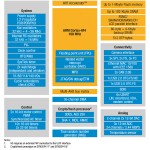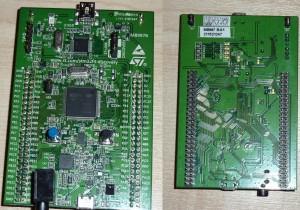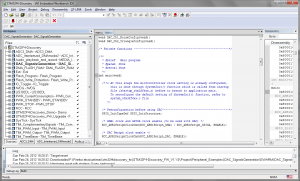STM32F4DISCOVERY is evaluation board with 32 bit ARM microcontroller and I’m surprised what features it can offer for around 11 euros.
Main features:
- STM32F407VGT6 32-bit ARM microcontroller @168 MHz with 1 MB Flash, 192 KB RAM.

- Hardware debugging(limited On-board ST-LINK) via USB
- USB OTG port for connecting mouses, keyboards, USB flash drives
- 3 axis digital accelerometer ±2g/±8g with programmable triggers
- Digital microphone
- DAC with microphone socket
- 4 user controllable LED’s
With this development kit comes only board, no manuals, no software, no USB cables. Manuals and code examples can be found on the internet. Over 20 code examples are prepared for these development environments:
- Altium, TASKING™ VX-Toolset
- Atollic, TrueSTUDIO
- IAR, EWARM (used by me)
- Keil™, MDK-ARM
Based on the IO_Toggle example I have wrote a little program, that lights up random LED’s based on the STM32F4 true random number generator.
/**
******************************************************************************
* @file IO_Toggle/main.c
* @author MCD Application Team
* @version V1.0.0
* @date 19-September-2011
* @brief Main program body
******************************************************************************
* @attention
*
* THE PRESENT FIRMWARE WHICH IS FOR GUIDANCE ONLY AIMS AT PROVIDING CUSTOMERS
* WITH CODING INFORMATION REGARDING THEIR PRODUCTS IN ORDER FOR THEM TO SAVE
* TIME. AS A RESULT, STMICROELECTRONICS SHALL NOT BE HELD LIABLE FOR ANY
* DIRECT, INDIRECT OR CONSEQUENTIAL DAMAGES WITH RESPECT TO ANY CLAIMS ARISING
* FROM THE CONTENT OF SUCH FIRMWARE AND/OR THE USE MADE BY CUSTOMERS OF THE
* CODING INFORMATION CONTAINED HEREIN IN CONNECTION WITH THEIR PRODUCTS.
*
* <h2><center>© COPYRIGHT 2011 STMicroelectronics</center></h2>
******************************************************************************
*/
/* Includes ------------------------------------------------------------------*/
#include "stm32f4_discovery.h"
/** @addtogroup STM32F4_Discovery_Peripheral_Examples
* @{
*/
/** @addtogroup IO_Toggle
* @{
*/
/* Private typedef -----------------------------------------------------------*/
GPIO_InitTypeDef GPIO_InitStructure;
/* Private define ------------------------------------------------------------*/
/* Private macro -------------------------------------------------------------*/
/* Private variables ---------------------------------------------------------*/
/* Private function prototypes -----------------------------------------------*/
void Delay(__IO uint32_t nCount);
void RNG_Config(void);
/* Private functions ---------------------------------------------------------*/
/**
* @brief Main program
* @param None
* @retval None
*/
int main(void)
{
uint32_t random32bit = 0;
/*!< At this stage the microcontroller clock setting is already configured,
this is done through SystemInit() function which is called from startup
file (startup_stm32f4xx.s) before to branch to application main.
To reconfigure the default setting of SystemInit() function, refer to
system_stm32f4xx.c file
*/
/* GPIOD Periph clock enable */
RCC_AHB1PeriphClockCmd(RCC_AHB1Periph_GPIOD, ENABLE);
/* Configure PD12, PD13, PD14 and PD15 in output pushpull mode */
GPIO_InitStructure.GPIO_Pin = GPIO_Pin_12 | GPIO_Pin_13| GPIO_Pin_14| GPIO_Pin_15;
GPIO_InitStructure.GPIO_Mode = GPIO_Mode_OUT;
GPIO_InitStructure.GPIO_OType = GPIO_OType_PP;
GPIO_InitStructure.GPIO_Speed = GPIO_Speed_100MHz;
GPIO_InitStructure.GPIO_PuPd = GPIO_PuPd_NOPULL;
GPIO_Init(GPIOD, &GPIO_InitStructure);
/* RNG configuration */
RNG_Config();
while (1)
{
/* Wait until one RNG number is ready */
while(RNG_GetFlagStatus(RNG_FLAG_DRDY)== RESET)
{
}
/* Get a 32bit Random number */
random32bit = RNG_GetRandomNumber();
GPIO_Write(GPIOD, (random32bit&0xF)<<12) ;
/* Insert delay */
Delay(0x7FFFFF);
}
}
/**
* @brief Delay Function.
* @param nCount:specifies the Delay time length.
* @retval None
*/
void Delay(__IO uint32_t nCount)
{
while(nCount--)
{
}
}
void RNG_Config(void)
{
/* Enable RNG clock source */
RCC_AHB2PeriphClockCmd(RCC_AHB2Periph_RNG, ENABLE);
/* RNG Peripheral enable */
RNG_Cmd(ENABLE);
}
#ifdef USE_FULL_ASSERT
/**
* @brief Reports the name of the source file and the source line number
* where the assert_param error has occurred.
* @param file: pointer to the source file name
* @param line: assert_param error line source number
* @retval None
*/
void assert_failed(uint8_t* file, uint32_t line)
{
/* User can add his own implementation to report the file name and line number,
ex: printf("Wrong parameters value: file %s on line %d\r\n", file, line) */
/* Infinite loop */
while (1)
{
}
}
#endif
/**
* @}
*/
/**
* @}
*/
/******************* (C) COPYRIGHT 2011 STMicroelectronics *****END OF FILE****/
And there is demo video with a program above.
In this video is some bit of demonstration of ST-Link debugging features.
In conclusion it’s great evaluation board for it’s price, although programming is not as user friendly and simple as with Arduino, but it’s low cost for variety of features and powerful processor.

